by Todd Rutherford
You may have heard recent dire reports about the health of bees and butterflies. Whether it’s the declining number of the amazing Monarch Butterfly or the constant reports of “colony collapse disorder” in beehives, these reports are alarming. One of the best and easiest things you can do to help these crucial creatures survive and thrive is to plant the perennials, shrubs and trees in your landscape that will give bees and butterflies the food they depend on. Help these pollinators while creating an inviting outdoor space for yourself. Or, if you are pondering the possibility of updating your landscaping in the near future, let Outdoor Design Group design a bee and butterfly friendly garden for you.
Below are listed several different perennials, shrubs and trees that provide food for bees, butterflies and other pollinators. While I’ve listed several pollinator friendly plants here, there are still many more to choose from. Consult the Xerces Society, a nonprofit organization that protects wildlife through the conservation of invertebrates and their habitat, or your local university extension agent for more suggestions of pollinator friendly plants that will grow well in your area.
Perennials for Butterflies and Bees
Asclepias species. Commonly referred to as the Milkweeds due to their milky sap, there are many species in the Asclepias genus that are utilized by butterflies and bees. Many biologists believe that the decline in the Monarch butterfly population is directly correlated to the increasing use of herbicides used to kill Milkweeds in North America, because Monarch butterflies depend on Milkweeds as food for their larvae. There are many Asclepias species that grow in North America, but two that do well in Colorado are Asclepias tuberosa (showy milkweed) and Asclepias speciosa (butterfly weed). Ht. and Wd. varies depending on species and cultivar, generally 15-60” Ht. x 12-18” Wd.
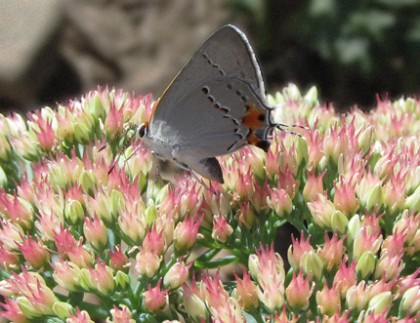
The Mint Family (Lamiaceae). Many familiar and popular garden plants from the so-called Mint Family are favored by bees. Some of these are culinary sage, Russian sage, mint, basil, rosemary, oregano, thyme, lavender, lamb’s ear, hyssop, lemon balm, and bee balm. Ht. and Wd. varies depending on species and cultivar.
Sedum ‘Autumn Joy’. This tall stone crop flowers in mid to late summer (see photo above), making it a good late-season nectar source for pollinators when many other plants have stopped flowering. 18-24” Ht. x 12-18” Wd.
Datura wrightii Although Sacred Datura may not always be a perennial in all parts of Colorado, depending on the severity of the winter, bees love it’s flowers which emit an amazing scent, so even if it is frost tender and may need to be regrown from seed in colder areas, it is worth it. The bees will thank you. 18-24” Ht. x 6-8’ Wd.
Shrubs for Butterflies and Bees
Buddleia alternifolia ‘Argentea’, Silver Fountain Butterfly Bush. This butterfly bush blooms earlier than the other species and cultivars of Buddleia. This large shrub does well in most soils and sites but doesn’t like its roots to stay wet. 12-15’ Ht. x 10-12’ Wd.
Caryopteris x clandonensis ‘Blue Mist’. Blue Mist Spirea is also in the Mint Family, and is not a true spirea, but has flowers that resemble those of the spirea. It is a hybrid of C. incana x C. mongolica that was created in the 1930’s in England by Arthur Simmonds. There are several cultivars of Caryopteris x clandonensis that are good choices for Colorado and which bees and butterflies (see photo below) love. 3-4’ Ht. x 2-3’ Wd.
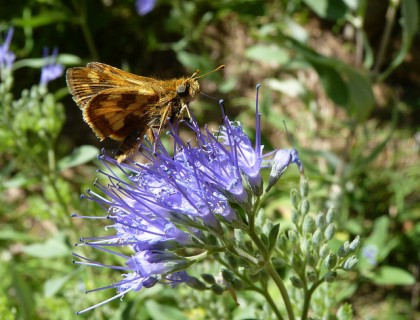
Mahonia. This genus has several members whose flowers will delight your winged friends. Mahonia aquifolium is a familiar shrub known as Oregon Grape Holly. It is evergreen, easy to grow and produces edible (but not tasty) berries from the yellow flowers that bees appreciate. 4-6’ Ht. x 4-6’ Wd.
Prunus bessyi, Sand Cherry 4-6’ Ht. x 4-6’ Wd.
Philadelphus lewisii, Cheyenne Mock Orange 5-7’ Ht. x 4-6’ Wd.
Rhus aromatica ssp. Trilobata, Three leaf sumac 3-6’ Ht. x 3-6’ Wd.
Rosa woodsii, Wood’s Rose 3-6’ Ht. x 3-6’ Wd.
Trees for Butterflies and Bees
Tilia cordata, Little Leaf Linden. Linden trees perfume the air in springtime and offer up small yellow flowers (see photo below) for pollinators. I’ve heard that in Eastern Europe, a type of beer is flavored with the linden flowers. 30-50’ Ht. x 25-35’ Wd. (depends on cultivar).
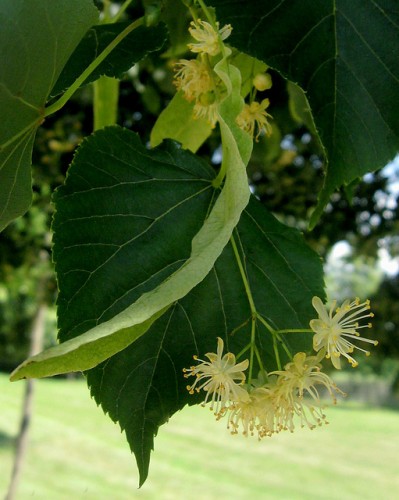
Apple / Crabapples. The Malus genus offers many species and cultivars that are attractive to bees. In fact, if there were no bees, you probably would not get any fruit from your apple trees. Ht. and Wd. varies depending on cultivar.
Prunus armeniaca ‘Moongold’, Moongold Apricot. 15-25’ Ht. x 15-25’ Wd.
Prunus nigra ‘Princess Kay’, Princess Kay Plum 15-20’ Ht. x 10-15’ Wd.
Catalpa speciosa, Western Catalpa 40-60’ Ht. x 30-50’ Wd.
Cercis Canadensis, Eastern Redbud 20-30’ Ht. x 20-30’ Wd.
Crataegus ambigua, Russian Hawthorne 15-25’ Ht. x 20’ Wd.
This is the official blog of Outdoor Design Group, Colorado Landscape Architects. For more information about our business and our services, click here.
Related Posts:
by Todd Rutherford
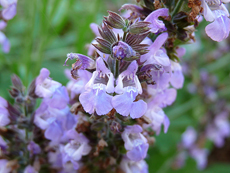
Culinary Sage
Many people may think that low-water gardening and edible plants are mutually exclusive. However, some of the tastiest culinary herbs are perennials that can find a home in your water-wise landscaping. So don’t just grow herbs in your vegetable garden, mix them into your perennial beds. While some of the culinary herbs need more water than extremely xeric plants, some of the best and most popular herbs are fairly drought tolerant, thriving in Colorado’s front-range climate.
Thyme is one commonly used herb that is fantastic when fresh. Even if you don’t intend to cook with fresh thyme, just picking a fresh sprig to crush in your hands, releasing the wonderful aroma, is reason enough to grow this versatile and hardy herb. Lemon thyme (Thymus citriodorus) is a great addition to cooked fish or chicken.
Lavender is one classic herb that loves Colorado’s growing conditions if you amend the soil to make it well-drained. Lavender is not commonly used in most American kitchens, but can be part of some amazing deserts and drinks. The best varieties for Colorado are Lavandula angustifolia ‘Hidcote’, Lavandula angustifolia ‘Munstead’ and Lavandula x intermedia ‘Provence.’
Oregano is perhaps one of the easiest herbs to grow in Colorado. In fact I’ve found that some varieties area so easily grown that they can become invasive due to their ability to re-seed. As with many herbs, some oregano varieties are better suited for cooking than others.
Culinary sage (Salvia officinalis) is more shrub like than the above listed herbs. As with the other herbs (most of which are in the Mint family) culinary sage produces gorgeous flowers that bees and other pollinators go crazy for. Culinary sage’s flowers are a gorgeous purple, blooming profusely in early summer. As with thyme, you may be familiar with its dried version, but fresh sage is much better.
A less drought tolerant group of herbs but that are still hardy and a nice addition to small pockets in flower beds are the chives. Regular chives and garlic chives are easy to grow and provide edible leaves and flowers. Toss in some fresh chive blossoms to your next breakfast egg dish, and you’ve turned an ordinary dish into something extraordinary.
This is the official blog of Outdoor Design Group, Colorado Landscape Architects. For more information about our business and our services, click here.
Related Posts:
by Matt Corrion
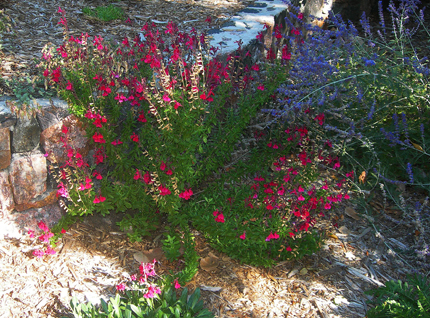
Furman’s Red Sage is wonderful small perennial that blurs the lines between perennial and shrub. It has a small, compact form and retains most of it’s leaves through the winter making it a more of a semi-evergreen shrub. And it’s magenta-red flowers just keep coming throughout summer and fall, making this plant a welcome addition to any dry landscape.
This plant combines well with many western natives, requiring little water and thriving in hot, sunny conditions. The unique bright colored flowers are a favorite of hummingbirds and gardeners alike.
PLANT STATS
Scientific Name: Salvia greggii ‘Furman’s Red’
Plant Type: Perennial or small semi-evergreen shrub
Mature Height: 24″-36″, stays pretty small and compact unlike many larger sages and mints
Mature Spread: 30″-42″
Cold Hardiness Zone: 5 – 9
Water Requirement: Low water needs. Seems to do equally well in dry conditions, or with supplemental irrigation. Follow a regular watering schedule the first growing season, but requires little water once established.
Exposure: Full Sun to light shade. Most of the literature on this plant says that it requires full sun, however I have experimented with it in partial shade and it also does well. In partial shade, flowering seems to start later in the summer/fall.
Flower Color & Bloom Time: Flowers are magenta to red, often exhibiting a unique bright magenta hue that sets this plant apart from other red flowering plants. Blooms appear in early to mid-summer and continue in fall through the first frost.
Winter Interest: Furman’s Red Sage grows into a small evergreen shrub that retains it’s leaves throughout winter, unlike most perennials.
Disadvantages: I have not found any to date. If given too much water or placed in too much shade, plants tend to get a little “leggy”, but since they stay relatively small they tend to still stay pretty compact and do not flop like excessively like larger perennials.
Availability and Sizes: This plant seems to be regularly available and has gotten quite popular. It is typically sold in 4-6″ pots, but may be found in 1 gallon containers as well.
Maintenance Tip: Cut back low to the ground in early spring to promote new growth. Leave evergreen stems and leaves up through the winter, some die-back may occur in cold winters.
Wildlife Value: Hummingbirds are attracted to the red flowers and regularly feed at this plant. Said to be deer resistant.
Best Features: Attractive magenta-red flowers that appear over a long period. This plant starts flowering in the middle of summer and continues flowering through late in the fall- one of the latest flowering plants here in Colorado.
Other: Also known as “Furman’s Red Texas Sage” or “Furman’s Red Autumn Sage”.
This is the official blog of Outdoor Design Group, Colorado Landscape Architects. For more information about our business and our services, click here.
Related Posts:
by Matt Corrion
By now most people in the western U.S. are familiar enough with Xeriscape to know that there is indeed no “zero” in the pronunciation (it’s pronounced more like zeer-escape). The term 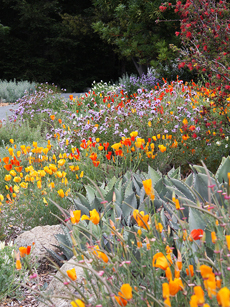 was coined by the Denver Water Department in 1981, are derived from the Greek word “xeros”, meaning dry.
was coined by the Denver Water Department in 1981, are derived from the Greek word “xeros”, meaning dry.
There are 7 principles that make up the concept of Xeriscape: planning and design, improving the soil, creating practical turf areas, irrigating efficiently, proper plant selection, using mulch, and maintaining the landscape.
While I am not sure EXACTLY when the 7 principles were first released (my guess is a few years after the term Xeriscape was first used), I have often wondered whether an update was needed, or if the same 7 principles would be adopted exactly the same today.
While today Xeriscape remains as relevant as ever, there are some important observations I have made through experience regarding the 7 principles, common misconceptions about them, and how they relate to landscaping in today’s rapidly changing world. Therefore, I thought it might be helpful to revisit and add updates to the original 7 principles:
Principle #1: Planning & Design
Updates: Planning and design is as important today as ever. Landscapes continue to get more complex as dozens of new plant choices are introduced each year, along with advances in irrigation systems and controllers. The more complex a project gets, the more benefit is gained from careful planning and design.
Another important development has been the landscape architecture license act of 2007, when Colorado joined the rest of the country in requiring that landscape architects be licensed, and that all commercial and large residential projects (greater than 4 units) have landscape plans that have been prepared by a licensed landscape architect. While this may have raised the cost of design somewhat, a good efficient design will always pay for itself by minimizing surprises during construction, allowing plans to be competitively bid, and lowering maintenance costs over time.
Misconceptions: Xeriscape can only be done in one style. A design will make the project cost more.
Principle #2: Soil Improvements
Updates: This is one area that needs to be looked at closer. The intention of this principle should be to “analyze and improve soil when needed, depending on what plantings are proposed”. The problem has been that many cities and municipalities started to require that all landscaped areas have large amounts of amendment incorporated into the soil over the entire landscaped area, and even requiring dump tickets from the contractors to prove that the amendments were placed.
While this is a good idea for bluegrass and for some types of plants, there are many other plants were the amendment is detrimental to plant health. Many of the very xeric and native plants prefer the native, rockier soil, and can suffer from root rot if soil is heavily amended with organics. I personally think that the amendment should only be tilled into new bluegrass areas, and in the individual planting backfill of those plants that will benefit from it.
Misconceptions: All plants require soil improvements.
Principle #3: Practical Turf Areas
Updates: I am not sure whether the original principle read “Practical Turf Areas” or “Practical Bluegrass Sod Areas”. One of the trends I am seeing that we are starting to use in our designs is the creation of “turf” areas from groundcovers and/or spreading perennials and shrubs. The questions that one needs to ask is not only where will the lawn areas be, but does an area really need to be a “lawn” at all?
Many of the bluegrass turf alternatives are very difficult and sometimes expensive to get established. If an area of the landscape will not be used for games and high foot traffic, then why substitute a hard-to-grow lawn alternative for bluegrass when there are many good spreading plants that are easy to grow? In other words, if a “turf” area will not be used, it simply becomes a low growing visual element, in which case many planting alternatives should be explored.
Misconceptions: Xeriscape means no grass, and bluegrass turf cannot be used in a Xeriscape.
Principle #4: Efficient Irrigation
Updates: Many advancements in irrigation have been made in the past several years, making it possible to irrigate even more efficiently. However, many of these benefits have been over-hyped. While I am all for making our irrigation systems more efficient, this approach does not address the underlying issue- how much water does my landscape REQUIRE to remain healthy? Only by installing water efficient landscapes will any major impact be made.
Misconceptions: If one installs new irrigation heads and a smart controller, the amount of water they will need to use will go down significantly.
Principle #5: Proper Plant Selection
Updates: This principle goes hand-in-hand with a good design. One of the overlooked aspects of this principle is a phenomenon known as “micro-climates”. Microclimates are small climate differences that occur in the landscape due to sun vs. shade relationships, water availability and retention, wind, soil differences, etc. Every day in this business I am reminded how plant selection is impacted by these micro-climates.
One area of debate is the natives vs. non-natives argument. I am firmly in the non-natives camp. There are some amazing native plants that I love to use, but there are also many non-natives discovered every year that meet the needs of our varying miro-climates.
Misconceptions: Only native plants are appropriate to use.
Principle #6: Mulching
Updates: The biggest problem I see with this principle is that all mulches are not created equal. There are cost, aesthetic, and weight differences between wood mulch and rock mulch. Not all plants like being heavily mulched, and some prefer rock mulch over wood mulch, for many of the same reasons some plants do not like a lot of soil amendment. As a result, wood mulch seems to be getting a bad name for Xeriscapes. I have even seen some cities write into code that wood mulch cannot be used for a low water-use zone. But wood is often quite a bit less expensive than rock mulch, and is WAY easier to move around, plant in, and make adjustment to than rock.
The bottom line on mulching- there are different rules to follow based on the type of mulch you are using. If you use wood mulch, use a thin layer and be sure not to over-water. If you use rock, remember that it will be difficult to add plants later or make changes to rocked areas. Also, keep in mid the aesthetics- I feel that too much rock can make a landscape seem a little too harsh, and but having a combination of mulch types can help to visually break up large areas.
Misconceptions: All mulch is the same, all plants love being mulched.
Principle #7: Maintenance
Updates: This is the most undervalued principle. For every 10 beautiful landscapes that I have designed and enjoy visiting time and again, there is at least one commercial landscape where even the most basic maintenance has been neglected. Shrubs have been sheared off into little balls right before they were about to flower, weeds have overtaken a bed area, plants have been over-watered to death.
The biggest piece of advice I can give to property owners or managers is this: walk your landscape once in a while, and make maintenance adjustments based on what you see. Remember that plants are living things, and your job is to understand what will allow each plant to flourish naturally, with the least amount of interference (such as over-watering, over-pruning, etc.) while at the same time minimizing negative factors such as pests, weeds, etc.
Misconceptions: All plants like more water, all shrubs need to be pruned, all plants have similar needs.
This is the official blog of Outdoor Design Group, Colorado Landscape Architects. For more information about our business and our services, click here.
Related Posts:
by Guest Writer
If you’re in the market to replace your existing deck or want to build a new one, you will want to know what products are available and what your contractor can do with them.
A beautiful deck starts with careful planning and design. The best looking deck often reflects some architectural elements from the house and uses them in the deck. If you have multiple decks on your home consider using matching handrails and decking material for uniformity. Consult with your builder or designer for the many options available today.
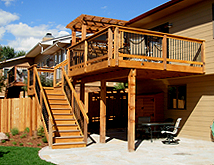 Overall deck costs tend to range from $25-$35 per square foot and cost varies due to height and complexity of construction. The cheapest decking material on the market is probably pressure treated pine the most expensive include exotic hardwood species and top-end coated composite decking. Here is a quick run-down on some of the decking materials available:
Overall deck costs tend to range from $25-$35 per square foot and cost varies due to height and complexity of construction. The cheapest decking material on the market is probably pressure treated pine the most expensive include exotic hardwood species and top-end coated composite decking. Here is a quick run-down on some of the decking materials available:
Decking Materials:
Redwood – soft wood prone to damage from hail, includes the removal of old growth forests that take centuries to recover. Redwood takes hundreds of years to mature and therefore is not a sustainable wood source. Redwood coast around $3-4 per linear foot depending upon the quality ordered.
IPE – Brazilian rainforest lumber that is very dense (hard) and durable. It has a dark color and requires pre-drilling for fasteners. I do not know of any that is sustainably grown / harvested lumber. IPE costs around $4 per linear foot depending on thickness used.
Tigerwood – Brazillian or African rainforest lumber that is very dense (hard) and durable. It has a light dark color variation (tiger striping) and requires pre-drilling for fasteners. I do not know of any that is sustainably grown / harvested lumber. Tigerwood costs around $4 per linear foot depending on thickness used.
Cedar – Soft wood prone to damage from hail, be sure to specify better grades of wood and tight knot or better, can come rough sawn for beams or trimmers and works well for handrails. Tight knot cedar cost around $2 per linear foot and the price almost doubles for clear cedar.
Pressure treated pine: Typically made from southern yellow pine which is pressure treated forcing chemicals into the wood that resist rotting and insect damage. The treatments usually contain copper compounds & other chemicals that are highly corrosive to metals, so extra zinc treatment to galvanized fasteners is recommended to avoid rusting. Older treated wood, produced prior to 2004, often contain arsenic & chromium which can be easily released if burned. It is important to allow the wood to dry out prior to staining or sealing. Pressure treated wood is prone to warping, splitting and twisting and these qualities seem to be exacerbated in dry climates. I believe that staining & sealing these woods can help their look and performance. P.T. pine should be either screwed in place nailed with 16d ring shank nails all fasteners should be hot dipped galvanized.
Composite:
Should you use real wood or composite decking? In the last ten years composite decking materials (plastic/ wood particles glued together) have taken hold of the market and are used on over half the decks being built. Several companies use 90% recycled plastics in their products which will help reduce waste. However, I do not know of any composites that are recyclable when they need replacement. If decking could be continually recycled it would truly be a sustainable product, but no companies, to my knowledge, have produced such a product. All composite decking materials rely on a type of adhesive or glue that bond all of the plastic and wood particles together. These adhesives can be any number of polymers(resin) some which can cause environmental concern if released into the environment especially if burned. The life span of composite decking is similar to a wood deck that is maintained, around 25 years. Eventually all decking materials will end up in a landfill.
There are around ten different companies producing composite deck materials in the U.S. with Trex being one of the first and widely know. These materials include decking and handrail systems and most companies offer different product lines that vary in color and consistency. One California company even offers a bamboo composite BamDeck which uses 30% bamboo and 70% recycled plastic.
The cost of composite decking varies from $2-$4 per linear foot of decking board. Common sizes for composite decking boards are 12’, 16’, 18’ and some 24’ lengths are available from certain manufacturers. Try to design your deck so that no butt joints are required. Composite boards require spacing butt joints from 1/8”-1/4” for board expansion which can be unsightly.
THE GOOD
- Composite decking does not require as much maintenance as natural wood products.
- Does not splinter or split.
- Have built in slip resistance.
- Are consistent in color, shape, and texture.
- Grooved boards can utilize hidden fastener systems which are attractive.
- Boards can be heated and bent into circular patterns.
- Boards are often made with recycled plastic materials up to 90%, which make it more sustainable.
THE BAD
- Boards without a pvc treatment are prone to staining from many different sources. PVC treatments usually cost around $1 more per linear foot of board.
- Material holds heat and can reach temperatures that will burn bare feet in the summer.
- Material is not structural and typically requires a maximum joist spacing of 16 inches, which also limits what can be done with handrails.
- Material shrinks and swells more that wood which requires spacing at butt joints if used.
- Material requires pre-drilling in many circumstances for fasteners.
- Catastrophic failure, rapid deterioration is possible and almost all manufacturers have had to warranty their product for this reason at one time.
- Material is not recyclable.
- Polymers used to glue product together can be harmful if released into the environment, i.e. burning.
People often ask me what is the best composite to use and to be honest I don’t know. The reason for this is that almost all of the companies making composite materials have produced materials that have failed and needed to be replaced.
In 2009 Louisiana Pacific recalled around 48 million linear foot of decking that was sold under three different trade names (WeatherBest®, ABTCo., and Veranda®). Many other companies have had warranty claims for products that are less than five years old. When composite decking fails you will often notice that the color comes off like chalk when you rub it with a finger.
Once composite decking boards start to fail, they can simply start to rot or you may notice flaking, splits, bubbling or other abnormalities. Boards can also break between joists in extreme failures causing injury. Warranties vary from company to company, but in general you can expect a limited 20 year warranty. One thing to note is that the manufacturer’s warranty will only cover material replacement, not labor to remove the old boards and replace them, which can be a substantial cost. Therefore, do your homework and make an informed decision based on a company’s track record.
Some things you should consider if you are planning to use composite decking:
- Texture (slip resistance) especially in frost prone areas.
- Color – try to compliment your homes color. Most composite deck materials fade 30% in the first year and then stabilize. Some even change color so look at samples that have been weathered when possible.
- Cost – almost everyone is on a budget so pick the best material you can afford.
- Warranty – since there have been failures in the past research the company’s products that you are considering and find out their track record and read the fine print on warranties.
- Maintenance – consult manufacturer’s suggestions but most can be cleaned with mild soaps and water.
There are a lot of things to consider when it comes time to build or replace a deck. A new deck can cost as much as a new car so take the time to weigh your options and hire a competent builder. I suggest that you not only talk with a builder’s past client but also take the time to see one of their completed projects.
No decking is completely environmentally friendly or sustainable. In general, many of the natural wood decking products available are from hardwoods or slow growing softwoods which make them less sustainable. Pressure treated southern yellow pine is a faster growing, more sustainable wood product but it utilizes chemicals for rot and insect resistance. If the composite decking industry can develop a product that is recyclable and will consistently perform it will climb to the top of the sustainability chart and my “A” list.
This is a guest post by Bruce Kehr. The owner of Sunlit Builders, LLC, Bruce is one of the top deck builders in Colorado. You can reach Bruce via email at [email protected].
Related Posts:





 was coined by the Denver Water Department in 1981, are derived from the Greek word “xeros”, meaning dry.
was coined by the Denver Water Department in 1981, are derived from the Greek word “xeros”, meaning dry. Overall deck costs tend to range from $25-$35 per square foot and cost varies due to height and complexity of construction. The cheapest decking material on the market is probably pressure treated pine the most expensive include exotic hardwood species and top-end coated composite decking. Here is a quick run-down on some of the decking materials available:
Overall deck costs tend to range from $25-$35 per square foot and cost varies due to height and complexity of construction. The cheapest decking material on the market is probably pressure treated pine the most expensive include exotic hardwood species and top-end coated composite decking. Here is a quick run-down on some of the decking materials available: